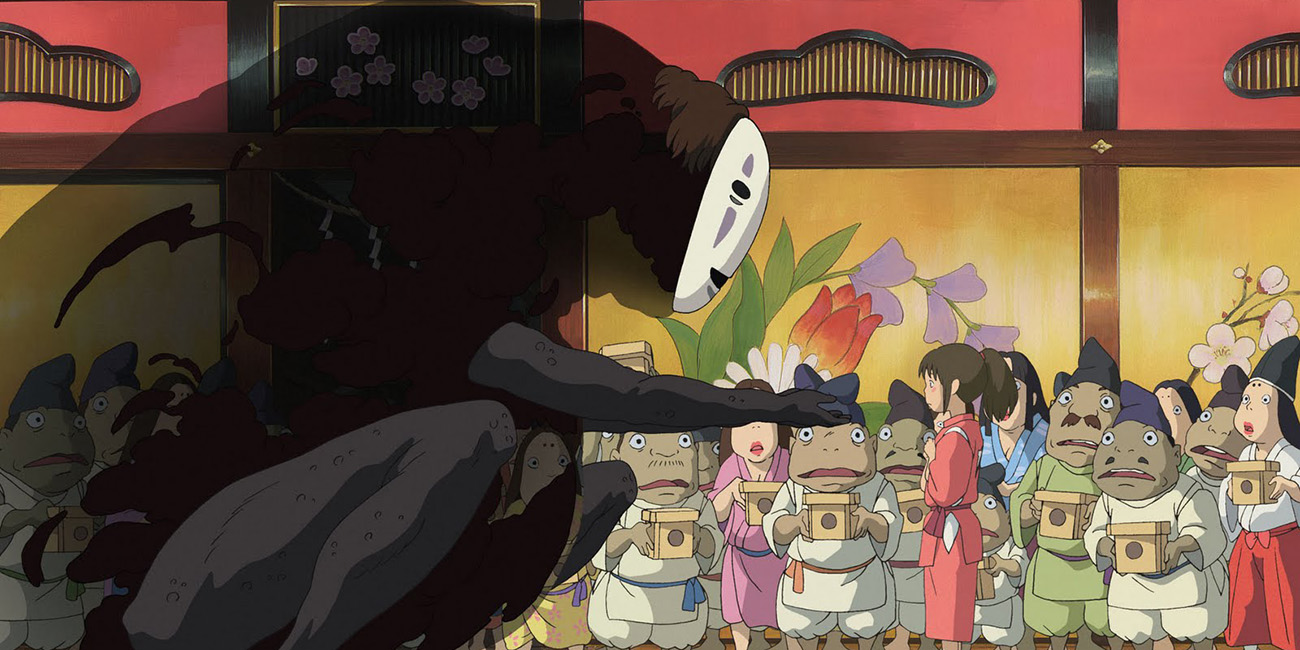
Japanese anime is not just Pokemon, Transformers and Hentai. In the world of visual culture they are of no smaller value than the cinema and figurative art. And although anime has generally been considered a transitory stage between traditional painting and movies, it’s actual role is a unifying one.
Before the invention of photography Japanese artists traditionally used etching techniques for fixing memorable events, samurai warriors and beautiful women – all those essential things. But try, discretely of course, adding a spaceship to one of those etchings and prints – put it into a corner somewhere – the resulting image will be anime. Anime has the same powerful drawing craftsmanship, the same mastery and the same traditions that engendered “the Waves” by Katsushika Hokusai. The whole heritage of Japanese visual art provided the basis for anime.
Isao Takahata’s latest film, “The Tale of Princess Kaguya” (2013) recreates traditional Japanese painting style. Basically, it is a sequence of animated ink drawings. For hundreds of years Japanese artists have been perfecting that technique. In the episode where the protagonist, in a crisis of disillusionment with urban life, tears her clothes off and runs back to her village, you can see how traditional drawing techniques have evolved. Sublime perfection.
There’s a quote I like from the creator of animation, Winsor McCay, who said, “When in the future people will look at a still picture they will wonder why it is not moving.” That’s why cartoonists are the bravest of all artists; they are ahead of everyone; they live in the future.
In Japan people of all generations watch anime. Animation has grown both in quality and theme range, but for the larger part it is more suitable for adults. And it is not a matter of pornography that is legal there: a big share of animated film production are serious animated films, with a serious humanistic message: “Grave of the Fireflies,” “The Wind Rises,” “Summer War,” “The Girl Who Leapt Through Time.” Those cartoons are for a grown-up audience, and in Japan they are treated with great reverence, of the kind that people have in respect of major artworks.
The U.S. animation has experienced its own Golden Age – and it wasn’t kids who iconized Bugs Bunny and Mickey Mouse, adults did it. But in mid-1960s animation lost its ground to the movie industry and had to put up with its role as a TV nanny for kids. It degenerated into kilometres long celluloids filled with primitive tasteless pictures that invaded television. Numerous TV channels sprouted up: they lowered animation standards, simplified it and forever attached it to the youngest consumers of visual produce. Whereas in Europe anime is watched mainly by adults because animation culture there has not been subjected to a rupture.
The world of animation is huge – even by Bollywood standards. Last time I tried to count anime films and series, they numbered over 45 thousand, of which I haven’t seen even a modest half. Once you get into this world, you risk experiencing a culture shock – even though there are so many magazines and books on anime – the internet is just full of it – the better part of it was created by fans for fans, so an outsider has difficulty trying to make it all out. As a result a lot of people feel pissed off; they promptly jump to conclusions by tagging anime lovers as crazy, and then they just quit. But animation calls for research work of a diligent kind, the same way as literature and music, but quite unlike movies, where the content can be easily consumed in accordance with your favorite movie theater schedule. And if you see the value of feature films as compared to anime in the acting of live actors, don’t you have a similar feeling in respect of, say, Rembrandt’s “Night Watch?”
{ “img”: “/wp-content/uploads/2015/02/anime_01.jpg”, “text”: “The Tale of the Princess Kaguya (2013)” },
{ “img”: “/wp-content/uploads/2015/02/anime_14.jpg”, “text”: “The Garden of Words (2013)” },
{ “img”: “/wp-content/uploads/2015/02/anime_15.jpg”, “text”: “Spirited Away (2001)” },
{ “img”: “/wp-content/uploads/2015/02/anime_04.jpg”, “text”: “Grave of the Fireflies (1988)” },
{ “img”: “/wp-content/uploads/2015/02/anime_17.jpg”, “text”: “Paprika (2006)” },
{ “img”: “/wp-content/uploads/2015/02/anime_05.jpg”, “text”: “The Wind Rises (2013)” },
{ “img”: “/wp-content/uploads/2015/02/anime_06.jpg”, “text”: “Summer Wars (2009)” },
{ “img”: “/wp-content/uploads/2015/02/anime_07.jpg”, “text”: “The Girl Who Leapt Through Time (2006)” }
The reason for anime’s “‘tarred reputation” are the events from 1997. A Pokemon episode was being projected in a cinema in Japan and because of the flash effect, and a heightened frame rate during the attack of one of the characters, a few kids complained of an ailment. There were no grave consequences, but the total number of children who experienced the sickness effect throughout the country was at least 12,000! That scene was cut out of the episode, and a special law amendment was passed obliging cartoonists to observe certain limitations as to the frame rate. That was the end of the incident. But the media blew it up to a degree where Japanese animation acquired some major negative connotations: everywhere in the world people were picturing children shaken by convulsions and teenagers going nuts. Well, I guess it cannot be helped. You either believe in ghosts or you don’t.
Hayao Miyazaki is the only Oscar-winning animator, a person of the same caliber as Akira Kurosawa. The only one for how much longer, who is next? The old guys from the Film Academy take years, decades of years to realise that there’s something interesting going on in the anime world, while young cartoonists spend their lifetime trying to get noticed in Hollywood. Most film critics nowadays will still look down on anime, no matter how popular it is with the audience.
The works of Shinichirō Watanabe and Mamoru Hosoda are less well known than “Pokemon” and “Sailor Moon,” but are much more in line with the anime tradition. The works of Satoshi Kon are without a doubt among the best films of the 20th century: “Millennium Actress” and “Tokyo Godfathers” evoke profound emotions. Only real art can do that. Of course talent of this scale is very rare in the world of anime – and in the world in general. So those who are blessed with it have long become classics.
From the younger generation, I would say Mamoru Oshii and Hideaki Anno, the director of “Neon Genesis Evangelion,” without a doubt an iconic work, are truly remarkable. They represent the part of anime that, likewise cinema, is trying to appeal to varied categories of viewers, so they keep up with the hectic information consumer speed.
{ “img”: “/wp-content/uploads/2015/02/anime_08.jpg”, “text”: “Millennium Actress (2001)” },
{ “img”: “/wp-content/uploads/2015/02/anime_09.jpg”, “text”: “Tokyo Godfathers (2003)” },
{ “img”: “/wp-content/uploads/2015/02/anime_10.jpg”, “text”: “Mononoke (2007)” },
{ “img”: “/wp-content/uploads/2015/02/anime_11.jpg”, “text”: “Evangelion: 1.0 You Are (Not) Alone (2007)” },
{ “img”: “/wp-content/uploads/2015/02/anime_16.jpg”, “text”: “5 Centimeters Per Second (2007)” },
{ “img”: “/wp-content/uploads/2015/02/anime_12.jpg”, “text”: “Cowboy Bebop (1998)” },
{ “img”: “/wp-content/uploads/2015/02/anime_13.jpg”, “text”: “Ghost in the Shell (1995)” },
{ “img”: “/wp-content/uploads/2015/02/anime_18.jpg”, “text”: “Redline (2009)” }
Irrespective of technological improvements to the process, a huge bulk of work is done by hand. Anime is still hand-drawn for the better part – and that is a big part of its magic. But one kind of art does not replace another one: creative work of a painter cannot be replaced by creative work of a photographer, the same way as animation cannot be replaced by movies.
Anime can be frightening, beautiful, touching. It can make you cry or laugh out loud, feel sad or feel happy. But doesn’t music and literature do the same thing?
Unlike the cinema, anime doesn’t work for the box office. That’s the unique thing about it: people watch anime with friends at home or by themselves on their phones in public transport. Anime has become an art form for individual perception, it needs to be watched and discussed in an inner circle. So while the television remains dominated by Cartoon Network and the likes of it, and cinema theatres show Disney and Pixar, anime remains the jazz of the visual world. Very popular but incredibly personal at the same time.





